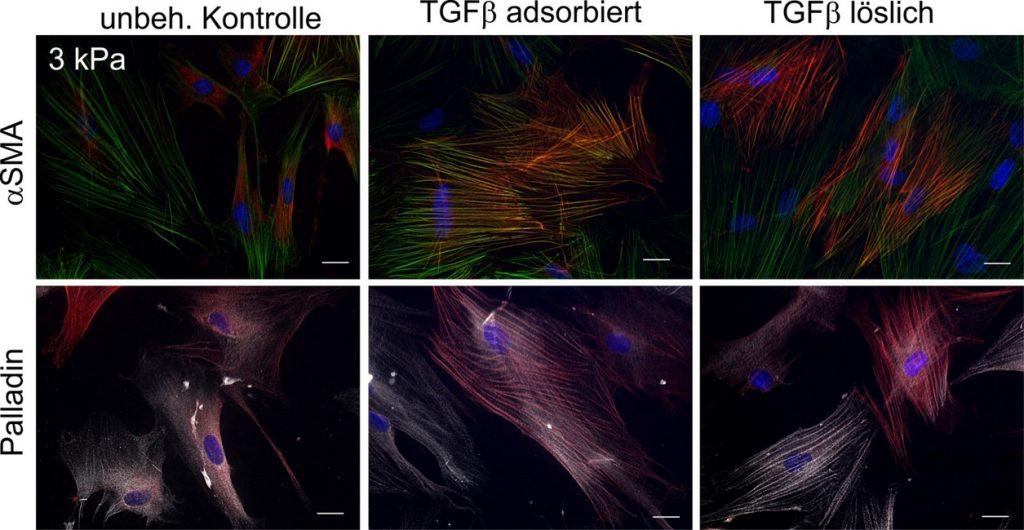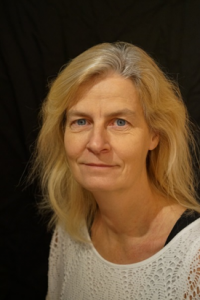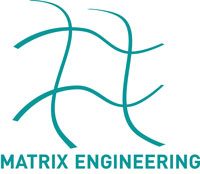
B4 – Influence of artificial extracellular matrices on fibroblast functions
Fibroblasts synthesize the major part of the extracellular matrix (ECM) and receive functionally relevant information from the surrounding ECM. This information may change metabolic parameters in the fibroblast cells. Matrix derived stimuli may be the matrix proteins itself, their degradation products and soluble mediators that are bound to or released from the matrix. Furthermore, physical properties of the ECM may influence fibroblast physiology. One can suppose that the introduction of artificial matrices into a tissue will modify tissue homeostasis and fibroblast physiology.
The project aims to develop artificial matrices for implant coating and scaffold structures that are able to support effective tissue regeneration by fibroblasts. We focus on the ability of artificial, GAG-containing ECM to bind and release essential mediators like TGF? or HB-EGF thus improving tissue regeneration by fibroblasts. Based on binding and release kinetics of different three-dimensional matrices we will focus on their behavior in wound healing studies in future.
In co-operation with our SFB-partners who develop artificial matrices (A1, A3, A10, Z3) we investigate the influence of these artificial matrices on the biology of human dermal fibroblasts using 3D cultures or organ cultures in vitro systems as well as mouse wound healing studies in vivo. Here we focus on activation of fibroblasts and differentiation to myofibroblasts. Due to complex regulatory networks during wound healing we will also investigate changes in inflammatory responses by applied artificial matrices in co-operation with project B3.
The evaluation of the in vitro experiments in mouse wound healing studies using wild type strains and strains with impaired wound healing will provide information on the clinical potential of the engineered GAG-containing matrices (with B3).

Publications
- Anderegg U, Halfter N, Schnabelrauch M, Hintze V. Collagen/glycosaminoglycan-based matrices for controlling skin cell responses. Biological Chemistry, vol. 402, no. 11, 2021, pp. 1325-1335. https://doi.org/10.1515/hsz-2021-0176.
- Thönes S, Rother S, Wippold T, Blaszkiewicz J, Balamurugan K, Moeller S, Ruiz-Gómez G, Schnabelrauch M, Scharnweber D, Saalbach A, Rademann J, Pisabarro MT, Hintze V, Anderegg U. Hyaluronan/collagen hydrogels containing sulfated hyaluronan improve wound healing by sustained release of heparin-binding EGF-like growth factor. Acta Biomater. 2019 Mar 1;86:135-147. doi: 10.1016/j.actbio.2019.01.029 . Epub 2019 Jan 17.
- Herbert D, Franz S, Popkova Y, Anderegg U, Schiller J, Schwede K, Lorz A, Simon JC, Saalbach A. High fat diet exacerbates early psoriatic skin inflammation independent of obesity: Saturated fatty acids as key players. J Invest Dermatol. 2018; 138:1999-2009.
- Picke AK, Campbell GM, Blüher M, Krügel U, Schmidt FN, Tsourdi E, Winzer M, Rauner M, Vukicevic V, Busse B, Salbach-Hirsch J, Tuckermann JP, Simon JC, Anderegg U, Hofbauer LC, Saalbach A. Thy-1 (CD90) promotes bone formation and protects against obesity. Sci Transl Med. 2018; 10:eaao6806.
- Picke AK, Campbell GM, Schmidt FN, Busse B, Rauner M, Simon JC, Anderegg U, Hofbauer LC, Saalbach A. Thy-1 Deficiency Augments Bone Loss in Obesity by Affecting Bone Formation and Resorption. Front Cell Dev Biol 2018;6:127.
- Ansorge M, Sapudom J, Chkolnikov M, Wilde M, Anderegg U, Möller S, Schnabelrauch M, Pompe T. Mimicking paracrine TGF-ß1 signals during myofibroblast differentiation in 3D collagen networks. Scientific Reports. 2017, 7:5664.
- Sapudom J, Ullm F, Martin S, Kalbitzer L, Naab J, Möller S, Schnabelrauch M, Anderegg U, Schmidt S, Pompe T. Molecular weight specific impact of soluble and immobilized hyaluronan on CD44 expressing melanoma cells in 3D collagen matrices. Acta Biomater. 2017;50:259-70.
- Thönes S, Kutz LM, Oehmichen S Becher J, Heymann K, Saalbach A, Knolle W, Schnabelrauch M, Reichelt S, Anderegg U. New E-beam-initiated hyaluronan acrylate cryogels sup-port growth and matrix deposition by dermal fibroblasts. Int J Biol Macromol. 2017; 94:611-20.
- Martin S, Wang H, Rathke T, Anderegg U, Möller S, Schnabelrauch M, Pompe T, Schmidt S. Polymer hydrogel particles as biocompatible AFM probes to study CD44 / hyaluronic acid inter-actions on cells. Polymer. 2016;102:342-9.
- Scharnweber D, Hübner L, Rother S, Hempel U, Anderegg U, Samsonov SA, Pisabarro MT, Hofbauer L, Schnabelrauch M, Franz S, Simon J, Hintze V. Glycosaminoglycan derivatives: promising candidates for the design of functional biomaterials. J Mater Sci Mater Med. 2015;26:232.
- Watarai A, Schirmer L, Thönes S, Freudenberg U, Werner C, Simon JC, Anderegg U. TGFß functionalized starPEG-heparin hydrogels modulate human dermal fibroblast growth and differentiation. Acta Biomater. 2015;25:56-75.
- Sapudom J, Rubner S, Martin S, Thönes S, Anderegg U, Pompe T. The interplay of fibronectin functionalization and TGF-ß1 presence on fibroblast proliferation, differentiation and migration in 3D matrices. Biomater Sci. 2015;3:1291-301.
- van der Smissen A, Hoffmeister PG, Friedrich N, Watarai A, Hacker MC, Schulz-Siegmund M, Anderegg U. Artificial extracellular matrices support cell rowth and matrix synthesis of human dermal fibroblasts in macroporous 3D scaffolds. J Tissue Eng Regen Med. 2015;25:56-75.
- Loth T, Hötzel R, Kascholke C, Anderegg U, Schulz-Siegmund M, Hacker MC. Gelatin-based biomaterial engineering with anhydride-containing oligomeric cross-linkers. Biomacromolecules. 2014;15:2104-18
- Anderegg U, Simon JC, Averbeck M. More than just a filler – the role of hyaluronan for skin homeostasis. J Exp. Dermatol. 2014, 23(5):295-303
- Franke K, Sapudom J, Kalbitzer L, Anderegg U, Pompe T. Topologically defined composites of collagen type I and V as in vitro cell culture scaffolds. Acta Biomaterialia 2014, 10(6):2693-702
- Anderegg U, Simon J, Averbeck M. More than just a filler – the role of hyaluronan for skin homeostasis. Exp Dermatol. 2014;23(5):295-303.
- van der Smissen A, Samsonov S, Hintze V, Scharnweber D, Moeller S,Schnabelrauch M, Pisabarro MT, Anderegg U. Artificial extracellular matrix composed of collagen I and highly sulfated hyaluronan interferes with TGF?1 signaling and prevents TGF?1-induced myofibroblast differentiation. Acta Biomater. 2013;9:7775-86.
- Müller SA, van der Smissen A, von Feilitzsch M, Anderegg U, Kalkhof S, von Bergen M. Quantitative proteomics reveals altered expression of extracellular matrix related of proteins of human primary dermal fibroblasts in response to sulphated hyaluronan and collagen applied as artificial extracellular matrix. J Mater Sci Mater Med. 2012;23:3053-65.
- Salbach J, Rachner T, Rauner M, Hempel U, Anderegg U, Franz S, Simon JC, Hofbauer LC. Regenerative potential of glycosaminoglycans for skin and bone. J Mol Med. 2012;90:620-35.
- Böhme J, Anderegg U, Nimptsch A, Nimptsch K, Hacker M, Schulz-Siegmund M, Huster D, Schiller J. De novo biosynthesis of GAG in the extracellular matrix of skin studied by MALDI MS. Anal Biochem. 2012;421:791-3. Van der Smissen A, Hintze V, Scharnweber D, Moeller S, Schnabelrauch M, Majok A, Simon JC, Anderegg U. Growth promoting substrates for human dermal fibroblasts provided by artificial extracellular matrices composed of collagen I and sulfated glycosaminoglycans. Biomaterials. 2011;32:8938-46.
- Willenberg A, Saalbach A, Simon JC, Anderegg U. Melanoma cells control hyaluronan synthesis in peritumoral fibroblasts via PDGF-AA and PDGF-CC: Impact on melanoma cell proliferation. J Invest Dermatol. 2012;132:385-93.
- Gebhardt C, Averbeck M, Diedenhofen N, Willenberg A, Anderegg U, Sleeman JP, Simon JC: Dermal Hyaluronan Is Rapidly Reduced by Topical Treatment with Glucocorticoids. J Invest Dermatol. 2009, 130(1):141-9.
- Anderegg U, Eichenberg T, Parthaune T, Haiduk C, Saalbach A, Milkova L, Ludwig A, Grosche J, Averbeck M, Gebhardt C, Voelcker V, Sleeman JP, Simon JC: ADAM10 is the constitutive functional sheddase of CD44 in human melanoma cells. J Invest Dermatol. 2009;129:1471-1482.
- Saalbach A, Arnhold J, Leßig J, Simon JC, Anderegg U. Human Thy-1 induces secretion of matrix metalloproteinase-9 and CXCL8 from human neutrophils. Eur J Immunol. 2008;38:1-13.
- Kloß D, Kurz RG, Jahnke HG, Fischer M, Rothermel A, Anderegg U, Simon JC, Robitzki AA. Micro cavity array (MCA)-based biosensor chip for functional drug screening of 3D tissue model. Biosens Bioelectron. 2008;23:1473-80.
- Gebhardt C, Averbeck M, Anderegg U and Simon J. Role of Hyaluronan in melanoma progression. In: R. Stern (ed). Seminars in Cancer Biology, 2009, Elsevier San Diego ISBN: 978-0-12-374178-3, 329-339.
- Voelcker V, Gebhardt C, Averbeck M, Saalbach A, Wolf V, Weih F, Sleeman J, Anderegg U and Simon J. Hyaluronan Fragments Induce Cytokine and Metalloprotease Upregulation in Human Melanoma Cells in part by signalling via TLR4. J Exp Dermatol. 2008;17:100-7.
- Saalbach A, Klein C, Sleeman J, Sack U, Kauer F, Gebhardt C, Averbeck M, Anderegg U, Simon JC. Dermal fibroblasts induce maturation of dendritic cells. J Immunol. 2007;178:4966-74.
- Busse K, Averbeck M, Anderegg U, Arnold K, Simon JC, Schiller J The signal-to-noise ratio as a measure of HA oligomer concentration: a MALDI-TOF MS study. Carbohydr Res. 2006;341:1065-1070.
- Sack U, Sehm B, Kahlenberg F, Murr A, Lehmann J, Tannapfel A, Uberla K, Moessner A, Dietrich A, Emmrich F, Lange F, Jungel A, Braun JM, Anderegg U. Investigation of arthritic joint destruction by a novel fibroblast-based model. Ann NY Acad Sci. 2005;1051:291–8.
Contact

PD Dr. rer.nat. Ulf Anderegg
Research Assistant and Head of the Research Laboratory
Faculty of Medicine
Clinic and Polyclinic for Dermatology, Venerology and Allergology
Philipp-Rosenthal-Straße 23, 04103 Leipzig
Phone: +49 (0)341 97-25881
E-Mail: ulf.anderegg@medizin.uni-leipzig.de

Dr. Anja Saalbach
Research Assistant
Faculty of Medicine
Clinic and Polyclinic for Dermatology, Venerology and Allergology
Philipp-Rosenthal-Straße 23, 04103 Leipzig
Phone: +49 (0)341 97-25880
E-Mail: anja.saalbach@medizin.uni-leipzig.de
